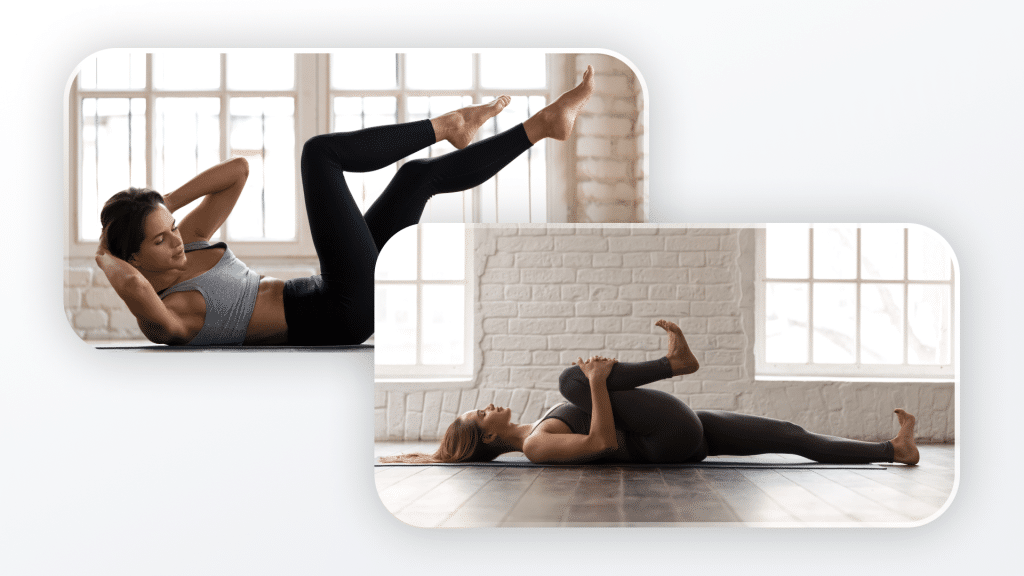You’re running and all of a sudden you feel a sharp pain in the back of your leg. You may have pulled your hamstring. Hamstring strains are one of the most common injuries, especially among athletes. Even if you’re not an athlete, the smarting pain behind your knee can put a real damper on your day. The good news is, there are some easy stretches you can do at home to relieve the pain and help your hamstring heal. Read on to learn more about the hamstring, what causes a pulled hamstring, and some of the best stretches to help you get back on your feet.
What Is The Hamstring?
Knee extension, or the act of straightening your leg, is powered by three muscles in the back of your thigh. These muscles are known as the hamstring. The hamstrings start at the bottom of your pelvis and attach to the bones in the back of your knee.
There are three muscles that make up the hamstring (1):
- Biceps femoris: This muscle is located on the outer side of your thigh. It has two heads, or origins, which is why it’s called biceps femoris. One head originates from the ischium, or bottom part of the pelvis, while the other head originates from the femur, or thigh bone.
- Semitendinosus: This muscle is located in the middle of your thigh. It also attaches to the ischium and femur bones.
- Semimembranosus: This muscle is located on the inner side of your thigh and also attaches to the ischium and femur.
Tendons attach the hamstring muscles to the bones in the back of your knee. These tendons are called the semitendinosus tendon, biceps femoris tendon, and semimembranosus tendon.
Apart from knee extension, the hamstring also helps with hip extension. This happens when you lift your leg behind you, like when you kick a soccer ball. The hamstring works with the gluteus maximus muscle to extend the hip.
Read More: Dumbbell Hamstring Exercises To Add To Your Routine
What Causes A Pulled Hamstring?
A pulled hamstring is a common injury, especially among athletes who participate in sports that involve sprinting, like soccer, football, and track. This is because sprinting puts a lot of stress on the hamstring muscle (2).
When the hamstring is overused or stretched beyond its limits, the muscle fibers can tear. This causes pain and tenderness in the back of the thigh. The injury can range from a mild strain to a complete tear of the muscle.
Hamstring strains are classified into three grades, depending on the severity of the injury (2):
- Grade 1: A mild strain that causes pain and tenderness in the back of the thigh. There may be some cramping, but you can still walk and put weight on your leg.
- Grade 2: A moderate strain that causes more pain and tenderness. You may have difficulty walking and putting weight on your leg.
- Grade 3: A severe strain that causes a complete tear of the muscle. You will feel a sharp pain in the back of your thigh and will be unable to walk or put weight on your leg.
Some causes of hamstring strains include (4):
- Tight muscles: If your hamstring muscles are tight, they’re more likely to be injured. This is because tight muscles can’t extend as far as loose muscles.
- Muscle fatigue: When the hamstring muscles are tired, they’re more likely to be injured. This is because tired muscles can’t contract as quickly as fresh muscles.
- Muscle imbalance: If the muscles in the front of your thigh are stronger than the muscles in the back of your thigh, you’re more likely to injure your hamstring. This is because the stronger muscles will pull on the weaker muscles, causing them to stretch further than they should.
- Poor flexibility: If your hamstrings are not flexible enough, they’re more likely to be injured. This is because tight muscles can’t extend as far as loose muscles.
- Poor warm-up: If you don’t warm up before exercise, your muscles will be cold and more likely to be injured. A proper warm-up will increase blood flow to the muscles and prepare them for activity.
BetterMe app will provide you with a host of fat-frying fitness routines that’ll scare the extra pounds away and turn your body into a masterpiece! Get your life moving in the right direction with BetterMe!
What Are The Signs Of A Pulled Hamstring?
The most common symptom of a pulled hamstring is pain in the back of the thigh. This pain can range from mild to severe, depending on the severity of the injury. Other symptoms include (4):
- Swelling: If your hamstring is swollen, it may be difficult to walk or put weight on your leg.
- Bruising: If your hamstring is bruised, you may see a black-and-blue mark on the back of your thigh.
- Tenderness: You may feel tenderness when you touch the back of your thigh.
- Weakness: You may feel weakness in your leg, making it difficult to walk or stand on your leg.
- Flexibility: You may have difficulty straightening your leg or bending your knee.
If you experience any of these symptoms, it’s important to see a doctor. A doctor can diagnose a hamstring injury and recommend treatment.
What Can You Do About A Pulled Hamstring?
If you have a pulled hamstring, there are several things you can do to ease the pain and speed up the healing process (3):
- Rest: The first and most important thing you can do is rest. This means avoiding activities that put stress on your hamstrings, like running and jumping.
- Ice: Applying ice to the injured area can help reduce pain and swelling. Do this for 20 minutes at a time, several times a day.
- Compression: Wearing a compression bandage can also help reduce pain and swelling.
- Elevation: Prop your leg up on a pillow when you’re sitting or lying down. This will help reduce swelling.
- Stretching and strengthening exercises: Once the pain and swelling have gone down, you can start doing stretching and strengthening exercises. These exercises will help improve flexibility and prevent future injuries.
The Best Exercises for Pulled Hamstring
Performing the right stretches and exercises can help ease pain and improve flexibility. Before starting an exercise program for hamstring strain, it’s important to talk with your doctor.
Light Stretches for Pulled Hamstring
Here’s how to do some light stretches for a pulled hamstring:
Towel Hamstring Stretch
- Lie on your back with a towel around your foot.
- Gently pull on the towel to stretch your hamstring.
- Hold the stretch for 30 seconds and repeat 3 times.
Hurdler Stretch
- Sit on the ground with your legs out in front of you.
- Bend one knee and place your foot flat on the ground.
- Keeping your back straight, lean forward and reach for your toes.
- Hold the stretch for 30 seconds and repeat 3 times.
Read More: Best Leg Exercises To Rock Your Quads, Glutes, And Hamstrings
Standing Hamstring Stretch
- Stand up straight with your feet shoulder-width apart.
- Bend one knee and place your foot on a chair or bench.
- Keeping your back straight, lean forward and reach for your toes.
- Hold the stretch for 30 seconds and repeat 3 times.
Strengthening Exercises for Pulled Hamstring
Once the pain and swelling have gone down, you can start doing strengthening exercises. Here are some exercises that can help strengthen your hamstrings:
Glute Bridge
- Lie on your back with your knees bent and feet flat on the ground.
- Squeeze your glutes and lift your hips off the ground.
- Hold for 2 seconds and lower back down.
- Repeat 10 times.
Single-Leg Deadlift
- Stand up straight with your feet shoulder-width apart.
- Hold a dumbbell in one hand and raise your other leg behind you.
- Keeping your back straight, lower your body until the dumbbell is close to the ground.
- Raise back up and repeat.
- Do 10 repetitions on each side.
Good Mornings
- Start with your feet shoulder-width apart and a dumbbell in each hand.
- Bend at your hips and lower your body until your thighs are parallel to the ground.
- Reverse the motion and return to the starting position.
- Repeat 10 times.
Hamstring Curls
- Lie on your stomach with your legs straight.
- Place a dumbbell behind your ankle and curl your leg up towards your butt.
- Return to the starting position and repeat.
- Do 10 repetitions on each side.
Betterme will keep you laser-focused on your weight loss journey! Nutrient-packed meal plans, fat-blasting workouts, galvanizing challenges and much more. Try using the app and see for yourself!
Balance Exercises for Pulled Hamstring
Balance exercises can also help prevent hamstring injuries. Here are some balance exercises to try:
Heel Raises
- Stand up straight with your feet shoulder-width apart.
- Slowly raise up on your toes and hold for 2 seconds.
- Lower back down and repeat. Do 10 repetitions.
Single-Leg Balance
- Stand on one leg with your arms at your sides.
- Hold the position for 30 seconds and then switch legs.
- Repeat 3 times on each side.
Calf Raises
- Start by standing behind a chair or countertop for support.
- Slowly raise up on your toes, hold for 2 seconds, and lower back down.
- Repeat 10 times.
Plyometric Exercises for Pulled Hamstring
Plyometric exercises are a type of exercise that involves explosive movements. These exercises can help improve power and prevent injuries. These should only be attempted once you have fully recovered from a hamstring injury.
Plyometric exercises for pulled hamstring:
Squat Jumps
- Start in a squat position with your feet shoulder-width apart and your hands behind your head.
- Jump up as high as you can and land softly back in the squat position.
- Repeat 10 times.
Lunge Jumps
- Start in a lunge position with your front leg bent at 90 degrees and your back leg straight.
- Jump up and switch legs in mid-air.
- Land softly with your opposite leg in a lunge position.
- Repeat 10 times on each side.
Box Jumps
- Start by standing in front of a box or bench.
- Squat down and jump up onto the box.
- Step down and repeat. Do 10 repetitions.
Prevention
The best way to prevent a hamstring injury is to:
- Warm up before exercising
- Stretch your hamstrings regularly
- Do strengthening and balance exercises
- Wear proper shoes
- Listen to your body and rest when you’re tired
Safety Considerations
Healing a pulled hamstring can take several weeks of stretches and exercises. To ensure you don’t further aggravate your injury, bear the following in mind:
- Don’t push through the pain. If an exercise is painful, stop and rest.
- Gradually increase the intensity and duration of your exercises.
- Prioritize form over speed or reps.
- If you experience a sharp pain, stop immediately and seek medical attention.
When Should You See A Doctor?
If you experience any of the following symptoms, it’s important to see a doctor:
- Severe pain: If the pain is severe, you may need medication to help relieve it.
- Inability to walk: If you can’t walk or put weight on your leg, you may have a more serious injury.
- Numbness or tingling: If you feel numbness or tingling in your leg, you may have a nerve injury.
- Sever swelling: If the swelling is severe, you may need to be seen by a doctor.
How Long Does It Take To Heal A Pulled Hamstring?
The healing time for a pulled hamstring depends on the severity of the injury. A mild injury may heal in a few weeks, while a more severe injury may take several months. If you have a severe injury, you may need surgery to repair the damaged muscle.
The Bottom Line
A pulled hamstring can be a painful and debilitating injury. However, there are things you can do to ease the pain and speed up the healing process. If you experience any of the following symptoms, it’s important to see a doctor: severe pain, inability to walk, numbness or tingling, or severe swelling. With proper treatment, most people make a full recovery.
Get your personalized
meal plan!
DISCLAIMER:
This article is intended for general informational purposes only and does not serve to address individual circumstances. It is not a substitute for professional advice or help and should not be relied on for making any kind of decision-making. Any action taken as a direct or indirect result of the information in this article is entirely at your own risk and is your sole responsibility.
BetterMe, its content staff, and its medical advisors accept no responsibility for inaccuracies, errors, misstatements, inconsistencies, or omissions and specifically disclaim any liability, loss or risk, personal, professional or otherwise, which may be incurred as a consequence, directly or indirectly, of the use and/or application of any content.
You should always seek the advice of your physician or other qualified health provider with any questions you may have regarding a medical condition or your specific situation. Never disregard professional medical advice or delay seeking it because of BetterMe content. If you suspect or think you may have a medical emergency, call your doctor.
SOURCES:
- Anatomy, Bony Pelvis and Lower Limb, Hamstring Muscle (2022, nih.gov)
- Hamstring Injuries in the Athlete: Diagnosis, Treatment, and Return to Play (2017, nih.gov)
- Hamstring Injury (2022, clevelandclinic.org)
- The mechanism of hamstring injuries – a systematic review (2020, biomedcentral.com)













